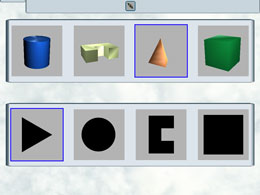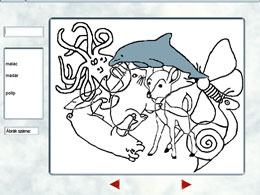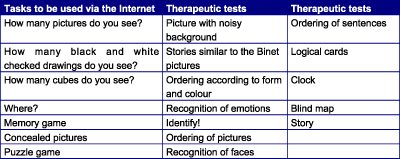
This issue in pdf Subscription Archive: Next issue: July 2005 |
|
|||||||||
Computer Controlled Cognitive Diagnostics and Rehabilitation Method for Stroke Patientsby Cecília Sik Lányi, Julianna Szabó, Attila Páll, Ilona Pataky The HELEN (HELp Neuropsychology) computer-controlled diagnosis and therapeutic system was developed at the Colour and Multimedia Laboratory at the University of Veszprém, Hungary during the period 2002-2004. It was prepared to support the diagnosis and therapy of stroke patients, to keep records of the rehabilitation process and to help the therapeutic process. The system has been successfully tested at the National Centre of Brain Vein Diseases. The system we have developed provides help for neuropsychological clinicians by supporting them in setting up the anamnesis, providing tests and training material for rehabilitation work and keeping track of patients' progress. The system contains a form for holding patients' personal data, numerous tests and tutorial tasks, and a database in which the rehabilitation process is archived. The single tasks contain decision-making situations, and the system provides assistance in these cases if the patient seeks it. In case of failure the system provides the possibility of a new trial. The method used by the patient to solve the problems is stored, as this represents important information for the neurologist. To enable the patient to find his or her best solution to the problem, we have developed interactive procedures that permit the solution to be reached using different cognitive approaches. It was important that the different routes taken by patients should not influence the test results, which are expressed in points, but should guide the rehabilitation process.
During the diagnostic phase of the rehabilitation, the program keeps track of the patient's problem-solving strategy and uses this in selecting the best rehabilitation plan. In order to do this, we use syndrome analysis, meaning our system is not merely a collection of computerized tests, but has been built in such a way that it uses the solution provided by the patient to select the next task. The system contains tasks that relate to perception, memory and attention, including writing, reading and counting tasks. Further on, a new aspect in our solution is that through modern technical support one can change the difficulty of the task by using colouring, changing the local or global stroke intensity, or adding noise.The program also numerically presents the efficiency of the task solution. This means that diagnostic and therapeutic programs are not only used according to the individual needs, but also supply exact results and comparative data. One can therefore investigate cognitive and behaviour deficits in such a way as to activate the intact functions of the brain, thereby allowing the patient to control the course of the procedures. The pace of the rehabilitation is thus influenced by the cooperation of the patient, and by this involvement one hopes that the rehabilitation speed will also increase. In addition, the main menu of the HELEN program is constructed in order to allow new tests and practicing tasks to be added at any time. The Specification of the Logical Structure of the HELEN Software
The tasks of the HELEN interactive and therapeutic test and teaching software are shown in the table.
Steps of the Solutions of the Applied Research The information stored in the database helps the neurologist to follow the individual rehabilitation path of the patient. It can also provide data on the typical behaviour of the patient, how he or she recognizes something, and give further insight into the sequencing of perception. In the future we intend to supplement the system with further sub-tasks, so as to increase the variety of tests the neurologist can use. Based on user feedback, we intend to include stories that are more interesting and understandable for the stroke patients, so that they become more interested and involved in the rehabilitation process. The rapid progress in the image-processing capabilities of modern computers enables the use of more sophisticated pictures, the introduction of animation, the use of virtual reality worlds etc. We are of the opinion that patients would appreciate more realistic presentations, stimulating them to become more involved and thus engage their mental capacity. All this could lead to quicker and more complete rehabilitations. Naturally this is at the present moment still only speculation; nevertheless, we feel it to be worth exploring, since it could help a non-negligible percentage of the now still inactive population to re-integrate themselves into normal life. The development of the system was supported by the National Research and Development Fund, Hungary, Grant no. NKFP 2/052/2001 Please contact: |
|||||||||




